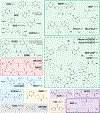New advances in cross-linking mass spectrometry toward structural systems biology
- PMID: 37406423
- PMCID: PMC11091472
- DOI: 10.1016/j.cbpa.2023.102357
New advances in cross-linking mass spectrometry toward structural systems biology
Abstract
Elucidating protein-protein interaction (PPI) networks and their structural features within cells is central to understanding fundamental biology and associations of cell phenotypes with human pathologies. Owing to technological advancements during the last decade, cross-linking mass spectrometry (XL-MS) has become an enabling technology for delineating interaction landscapes of proteomes as they exist in living systems. XL-MS is unique due to its capability to simultaneously capture PPIs from native environments and uncover interaction contacts though identification of cross-linked peptides, thereby permitting the determination of both identity and connectivity of PPIs in cells. In combination with high resolution structural tools such as cryo-electron microscopy and AI-assisted prediction, XL-MS has contributed significantly to elucidating architectures of large protein assemblies. This review highlights the latest developments in XL-MS technologies and their applications in proteome-wide analysis to advance structural systems biology.
Keywords: Cross-linking mass spectrometry; Integrative structural analysis; Protein complexes; Protein–protein interaction; Structural proteomics; Structural systems biology.
Copyright © 2023. Published by Elsevier Ltd.
Conflict of interest statement
Declaration of competing interest The authors declare that they have no known competing financial interests or personal relationships that could have appeared to influence the work reported in this paper.
Figures


References
-
- O’Reilly FJ, Rappsilber J: Cross-linking mass spectrometry: methods and applications in structural, molecular and systems biology. Nat Struct Mol Biol 2018, 25:1000–1008. - PubMed
-
- Britt HM, Cragnolini T, Thalassinos K: Integration of Mass Spectrometry Data for Structural Biology. Chem Rev 2022, 122:7952–7986. - PubMed
-
- Piersimoni L, Kastritis PL, Arlt C, Sinz A: Cross-Linking Mass Spectrometry for Investigating Protein Conformations and Protein-Protein Interactions horizontal line A Method for All Seasons. Chem Rev 2022, 122:7500–7531. - PubMed

